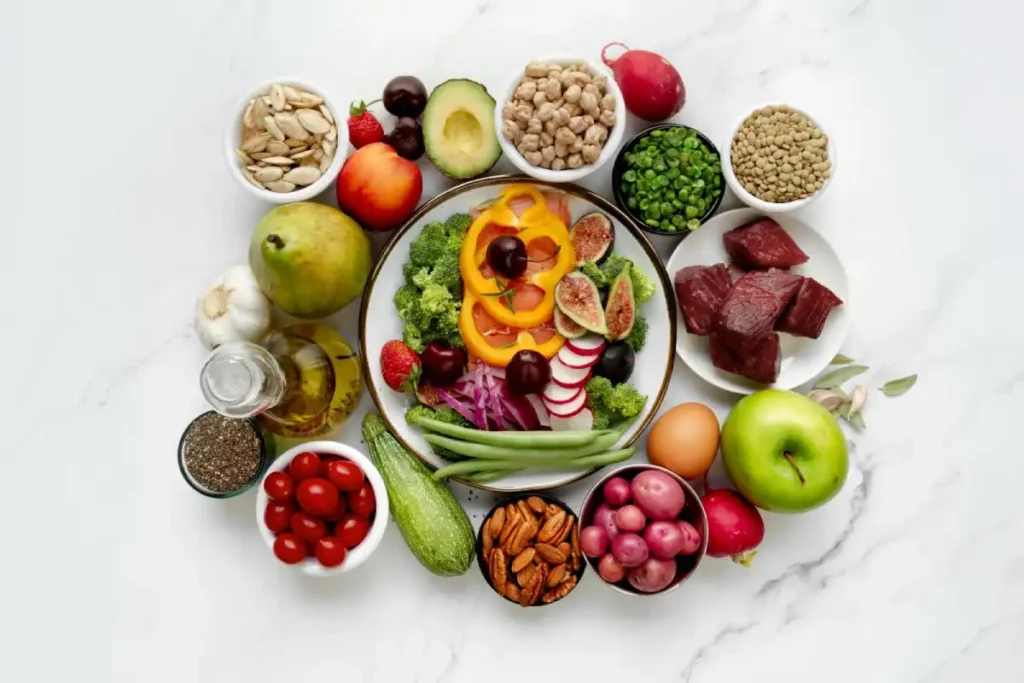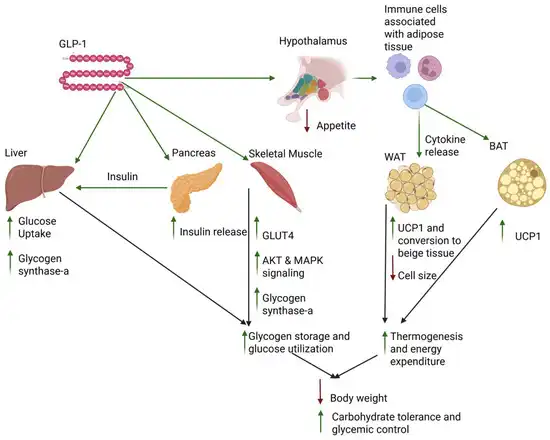GLP-1: Nature’s Ozempic? The Hormone That Helps You Feel Full

Ever finish a big meal and still find yourself hungry an hour later? On the other hand, some meals keep you satisfied for hours, with zero cravings in sight. The secret often lies not just in what you eat, but how your body responds to it.
The reason is the response of your gut hormone called GLP-1. Let’s explore how GLP-1 works, what foods naturally boost it (without relying on willpower alone).
What is GLP-1 and How Does It Work?
– GLP-1 (Glucagon-like Peptide-1) is a hormone that your gut produces when you eat.
– It helps you feel satisfied, regulate your energy levels, and reduce cravings.

Here’s how it works:
1. The brain sends signals of fullness to decrease appetite.
2. In the pancreas, GLP-1 supports insulin release to stabilize blood sugar levels.
3. In the muscles and liver, it assists your body in using glucose efficiently.
4. In fat cells, it promotes improved fat metabolism and reduces inflammation
🧪 All mechanisms are supported by the 2025 narrative review in Biomedicines, which highlights GLP-1’s multifaceted role in satiety, insulin regulation, glycogen production, and fat metabolism
GLP‑1 Medications Are Gaining Popularity; but at a High Price
GLP-1 medications like Ozempic and Wegovy are known for suppressing appetite and aiding weight loss. They mimic the action of GLP-1, helping individuals feel full faster.
While effective, they come with notable side effects, including nausea, digestive issues and some serious issues :
Vision Impairment Alert
Semaglutide, a widely used GLP-1 receptor agonist, has been linked to a significantly higher rate of reported vision problems. These issues can include blurred vision, worsening diabetic retinopathy, and problems related to the optic nerve.
🧪 A 2025 analysis of FDA adverse event reports indicated that the odds of reporting vision impairment with these drugs were nearly twice as high as for other medications.
Linked to Serious Pancreatitis Risk
It has also been associated with rare but severe cases of acute pancreatitis, which is a potentially life-threatening inflammation of the pancreas.
🧪 A 2024 study published found that 98% of reported cases of GLP-1-related pancreatitis were classified as serious, highlighting the need for increased medical caution.
Is Berberine Really Nature’s Ozempic?
With side effects of GLP‑1 drugs in the spotlight, berberine is gaining attention as a natural alternative. But does it really measure up?
Berberine is often labeled as “Nature’s Ozempic,” but this comparison is somewhat misleading. Both can aid in blood sugar control and weight management, but they work differently. Ozempic directly targets the GLP-1 hormone to reduce appetite, while berberine supports metabolism through the *AMPK pathway. Although it helps regulate glucose and fat, berberine is not as potent or fast-acting as Ozempic. Its benefits are real but more subtle, making it not a direct substitute.
*The AMPK pathway acts like your body’s energy sensor — helping regulate how it uses and stores fat and sugar.
🧪 A 2024 News Medical review notes that berberine activates the AMPK pathway, supporting metabolism, though its effects are milder than GLP-1 drugs like Ozempic.
Opt for natural options. Food and lifestyle that safely boost GLP-1 without side effects, making it an easy and sustainable choice for lasting satiety and health.

🧪 A 2020 study in Nutrition found that flavonoids in dark chocolate may boost GLP‑1 levels, aiding appetite control and glucose balance.
GLP-1 Friendly Meal Ideas
Need some inspiration? Here are a few balanced meals designed to naturally support GLP-1 and keep you full:
Sample Meal Plan
| Breakfast | 2 Eggs on Sourdough Toast + Avocado slices OR Dosa with sambhar and coconut chutney |
| Mid Morning | Chickpea Hummus + Veggie Sticks OR Small bowl of fresh fruit (e.g., papaya or berries) with Nuts |
| Lunch | Tuna or Egg Salad with Mixed Vegetables and a Lemon-Olive Dressing OR Rajma/Chana Curry with brown rice or millet (like jowar or bajra) + salad + Buttermilk |
| Snacks | Apple slices with almond butter OR Roasted Chana or Makhana |
| Dinner | Grilled tofu or salmon with quinoa and steamed broccoli OR Vegetable Khichdi with Moong Dal, topped with ghee |
These meals combine protein, fibre, and healthy fats, activating satiety hormones and balancing blood sugar without making you feel deprived.
Beyond Food: Lifestyle Habits That Support Satiety
It’s important to remember that boosting GLP-1 isn’t solely about what you eat. Simple lifestyle habits can also enhance their effects.
Here are a few tips:
– Eat Slowly: Give your body time to signal fullness. GLP-1 takes about 20 minutes to do its job, so rushed meals might lead to missed signals.
– Stay Hydrated: Sometimes, dehydration can mimic feelings of hunger.
– Prioritise Sleep: Lack of sleep can hinder your appetite-regulating hormones.
– Stay Active: Regular exercise improves insulin sensitivity and can enhance GLP-1 response.
Final Thoughts
In a world often filled with extreme diets and calorie counting, GLP-1 emerges as a quiet powerhouse that helps you feel full, stabilises energy levels, and helps you manage cravings. By nourishing your body in a way that supports this hormone, you’re not just helping yourself feel better; you’re also tuning into a more balanced, satisfying approach to eating.
References
- 1. D’Alessio, D. (2016, March 14). Is GLP‐1 a hormone: Whether and When? Journal of Diabetes Investigation, 7(S1), 50–55. https://doi.org/10.1111/jdi.12466
- 2. Kawakami, Y., Watanabe, Y., Mazuka, M., Yagi, N., Sawazaki, A., Koganei, M., Natsume, M., Kuriki, K., Morimoto, T., Asai, T., & Arai, H. (2021, May). Effect of cacao polyphenol-rich chocolate on postprandial glycemia, insulin, and incretin secretion in healthy participants. Nutrition, 85, 111128. https://doi.org/10.1016/j.nut.2020.111128
- 3. Logan, P. (2024, August 21). On The Increase in Use of GLP-1s. blogs. Retrieved August 1, 2025, from https://medicine.iu.edu/blogs/bioethics/on-the-increase-in-use-of-glp-1s
- 4. Lotosky, J., Jean, X., Altankhuyag, A., Khan, S., Bernotas, A., Sharafshah, A., Blum, K., Posner, A., & Thanos, P. K. (2025, June 30). GLP-1 and Its Role in Glycogen Production: A Narrative Review. Biomedicines. Retrieved July 30, 2025, from https://www.mdpi.com/2227-9059/13/7/1610
- 5. Zheng, Z., Zong, Y., Ma, Y., Tian, Y., Pang, Y., Zhang, C., & Gao, J. (2024, September 18). Glucagon-like Peptide-1 Receptor: Mechanisms and Advances in Therapy. Signal Transduction and Targeted Therapy. Retrieved July 30, 2025, from https://www.nature.com/articles/s41392-024-01931-z
- 6. Massy, M., Marti, S., Hammer, H., & Hoepner, R. (2025, April 6). Increased Vision Impairment Reports Linked to Semaglutide: Analysis of FDA Adverse Event Data. BMC Medicine. Retrieved August 1, 2025, from https://pmc.ncbi.nlm.nih.gov/articles/PMC11974072/
- 7. Is Berberine Really “Nature’s Ozempic”? What Science Says. (2025, April 30). News-Medical. https://www.news-medical.net/health/Is-Berberine-Really-e2809cNaturee28099s-Ozempice2809d-What-Science-Says.aspx
